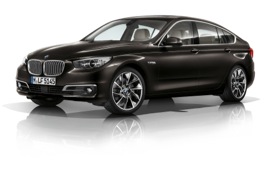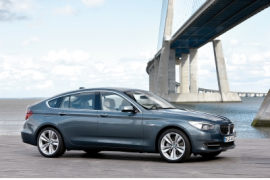BMW 5 Series Gran Turismo Models/Series Timeline, Specifications & Photos
First production year: 2009
Engines: Diesel, Gasoline
Body style: Hatchback
In 2013, BMW decided to upgrade the sixth generation of the 5 Series, and it also tried to improve the Gran Turismo version, which suffered from low sales compared to its sedan and estate versions.
BMW took a big gamble when it introduced the 5 Series Gran Turismo in 2009. The German automaker tried to provide customers with a mix between a 7 Series and an SUV. In theory, that should work well, but customers were not very attracted by the car’s exterior styling, which was far from being as attractive as the one offered by its sedan and estate siblings. But just like its siblings, the F10 and the F11, the 5 Series Gran Turismo (the F07) received an update in 2013, improving the vehicle in key areas. Furthermore, its exterior styling was significantly enhanced.
At the front, the 5 Series GT featured new bi-xenon headlamps with an option for Adaptive LED headlights that could automatically switch between the high and the low beam. BMW also slightly updated the look of the kidney grille, trying to make it look smaller. But still, the tall front fascia was challenging to conceal. To do that, the automaker redesigned the lower bumper and adorned it with horizontal chromed elements that made the car look wider.
From its profile, the 2013 5 Series Gran Turismo featured a redesigned tailgate that was extended rearwards, creating a more harmonious transition from the arched roofline to the sloped-down back. A new set of door mirrors featuring LED turn signals was also part of the LCI package and improved the vehicle’s look. Finally, at the back, the 5 Series Gran Touring received completely new LED taillights that emphasized the car’s width and provided a sportier appearance. Like its non-facelifted sibling, the 2013 F07 featured frameless door windows and, as an option, an openable panoramic glass roof.
Regardless of the car’s exterior, the cabin was both luxurious and airy. Its high-mounted seats and long wheelbase provided enough headroom and legroom for four passengers. The one seated in the middle, in the back, had to hump above the transmission tunnel, which was not comfortable on long travels. At the front, customers found thick and plushy bucket seats separated by a tall center console that housed the gear selector and the iDrive infotainment unit controller. On the dashboard, the automaker installed the new NBT system that featured a 16:9 ration display placed atop the center stack. Even though most interior elements looked similar to those from the 5 Series sedan (the F10), the comfort provided was closer to what a 7 Series (the F01) could offer.
Under the hood, the automaker installed a wide choice of engines, depending on the market. In the U.S., BMW sold the 5 Series Gran Turismo with either a turbocharged inline-six or a twin-turbo V8 paired with an eight-speed automatic transmission. In Europe, the automaker offered more options, including several turbodiesel powerplants.
BMW tried a new approach on the market with a niche vehicle named the 5 Series GT, which shared its platform with the 7 Series (F01).
The German automaker made a mix between its flagship limousine, the 7 Series, and the X6 Sport Activity Coupe crossover. It ended up with a vehicle that tried to cover more ground and provide enough comfort for four passengers and a decent luggage compartment. Moreover, its features and amenities were in a way richer than those provided on the 7 Series while its price was lower. It should've been a commercial success, but the world financial crisis that started in late 2008 hindered the automaker's plans. The 5 Series GT, on the other hand, was not built to win any design competition, and its potential buyers also noticed that.
At the front, the car featured big, swept-back headlights with clear turn signals mounted up on the outer sides. Between them, the broad kidney grille looked like it was carried over from an SUV. It tried to conceal the front's fascia height, which was taller than on a regular sedan. On the lower side of the bumper, BMW installed a wide mesh grille flanked with optional fog lamps.
From its profile, the long wheelbase of the 5 Series Gran Turismo was just three millimeters (0.1-inch) shorter than the one provided by the 2008 7 Series. Its tall front area was followed by a raked windshield that resembled the one from the X6. The arched roofline was sloped down and ended with an abrupt vertical drop behind the rear window. There, BMW installed a tailgate with a dual-opening system. Press one button, and only the flat lower panel opened, or another, and the entire tailgate would lift. That idea wasn't new since it was already shown on the Skoda Superb, but it proved practical, so BMW used it. This feature was unavailable on either the 7 Series or the on the X6. Another unique feature of the 5 Series GT was noticed on the door windows, which didn't have a frame, like in a proper GT or a sports car.
Inside, the 5 Series GT provided a high level of comfort with high-mounted seats for the front occupants, while in the back, BMW offered reclining seats and even a two-seat option instead of a bench seat. Fronting the driver was a rounded instrument cluster filled with two large dials for the speedometer and tachometer, flanked by the fuel level and engine temperature gauges. Atop the center stack, the automaker installed the wide format display for the infotainment system, controlled via a rotary dial on the center console between the front occupants.
Under the hood, the automaker installed a wide choice of engines ranging from a two-liter turbodiesel to a twin-turbocharged 4.4-liter V8. The former was provided exclusively with a rear-wheel drive. At the same time, all the other versions were available with BMW's xDrive AWD system. Power went to the rear or in all corners via a ZF eight-speed automatic transmission.
BMW 5 Series Gran Turismo 520d 8AT (184 HP)
BMW 5 Series Gran Turismo 530d 8AT (245 HP)
BMW 5 Series Gran Turismo 530d 8AT (258 HP)
BMW 5 Series Gran Turismo 530d xDrive 8AT (245 HP)
BMW 5 Series Gran Turismo 530d xDrive 8AT (258 HP)
BMW 5 Series Gran Turismo 535d 8AT (300 HP)
BMW 5 Series Gran Turismo 535d 8AT (313 HP)
BMW 5 Series Gran Turismo 535i 8AT (306 HP)
BMW 5 Series Gran Turismo 535i 8AT (315 HP)
BMW 5 Series Gran Turismo 535i xDrive 8AT (306 HP)
BMW 5 Series Gran Turismo 535i xDrive 8AT (315 HP)
BMW 5 Series Gran Turismo 550i 8AT (408 HP)
BMW 5 Series Gran Turismo 550i 8AT (450 HP)

